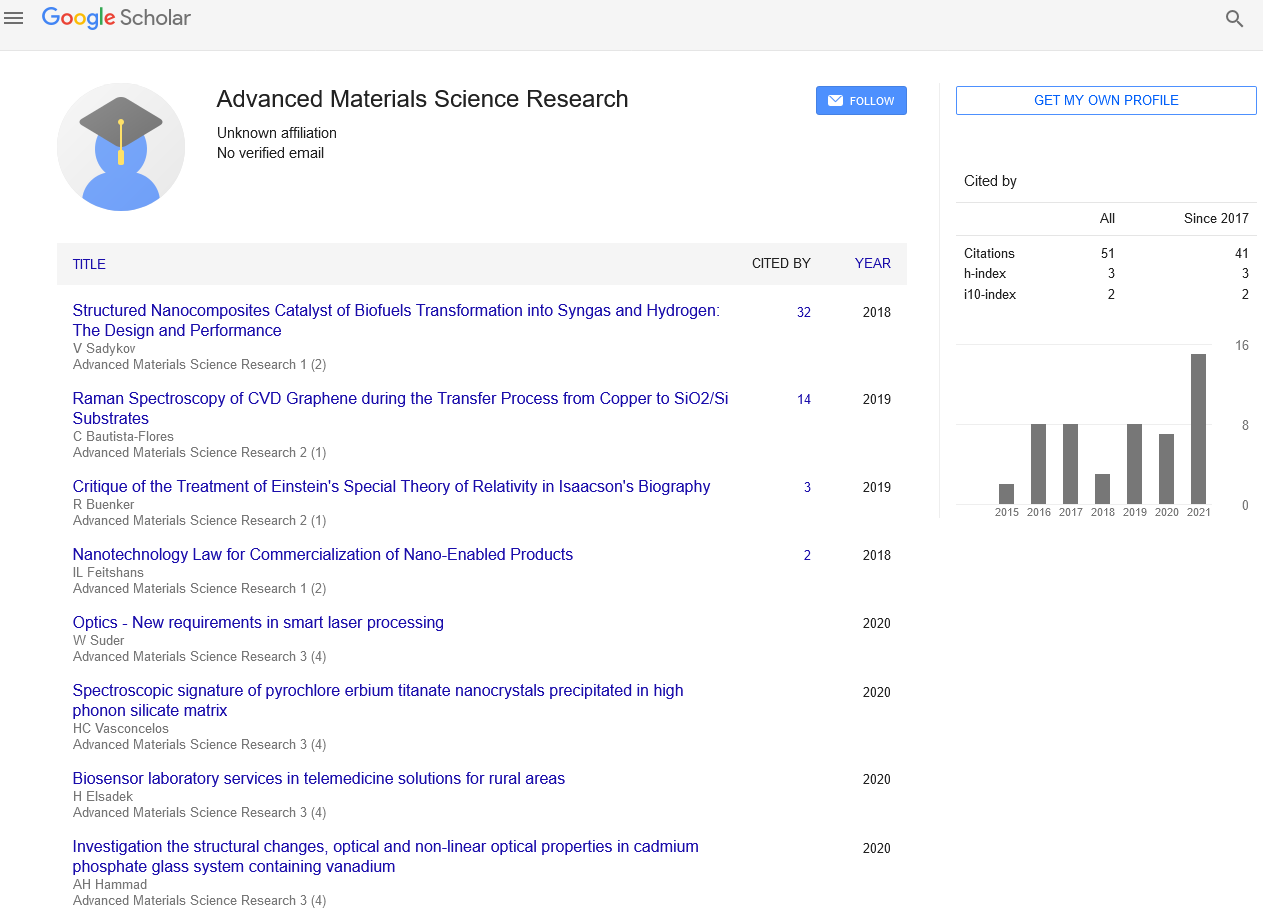Mini Review - Advanced Materials Science Research (2023) Volume 6, Issue 2
A Brief Note on Fluorescent Ceramics Prepared By Hot-Pressure Sintering
Barner Wang*
Department of Advanced Materials science Gambia
Department of Advanced Materials science Gambia
E-mail: Wang_b3@gmail.com
Received: 03-Apr-2023, Manuscript No. AAAMSR-23-96388; Editor assigned: 05-Apr-2023, Pre-QC No. AAAMSR-23-96388 (PQ); Reviewed: 19-Apr-2023, QC No. AAAMSR-23-96388; Revised: 21-Apr-2023, Manuscript No. AAAMSR-23-96388 (R); Published: 28-Apr-2023; DOI: 10.37532/ aaasmr.2023.6(2).28-30
Abstract
Five mullite foamed ceramics were made in this study using white clay, industrial alumina, and varying amounts of Si powder. The ceramics' compressive strength, alkali attack resistance, and thermal conductivity were evaluated in relation to the SiC whisker generation content that was controlled in situ by the various Si powder contents, and the optimal SiC whisker generation content was found. The porosity of the foamed ceramics decreased, the thermal conductivity increased, and the compressive strength first increased and then decreased as the Si powder content increased. The stability of ceramic matrices and a slower diffusion rate of alkali vapor enhanced the resistance to alkali corrosion. The optimized product was a specimen containing 10% Si powder, taking into account its mechanical, thermal, and alkali attack resistance properties
Keywords
Fluorescent ceramics • White clay
Introduction
Due to their low thermal conductivity and good thermal shock resistance mullite foamed ceramics play a significant role in the thermal insulating layer of equipment and furnaces. Secondary fuels (industrial waste and household garbage) have recently been used in the suspension preheater of cement industries, where a large number of alkali vapors, sulfur vapors, and chlorine vapors are produced, to reduce resource consumption and achieve energy-efficient combustion. These vapors can react with mullite to form sodium aluminosilicate and potassium aluminosilicate phases, which cause the mullite foamed ceramics to expand by 20–25% in volume and collapse thermally. Their service life is shortened as a result, making high-quality production impossible. Therefore, increasing the alkali corrosion resistance of the suspension preheater's mullite foamed ceramics is essential to extending their useful life.
Ceramics and refractories' ability to withstand alkali attack has been the subject of extensive research. Reduce the porosity and pore size of the refractories to reduce the diffusion of alkali vapor within them, which can be accomplished by lowering the gas permeability. Ren prepared bauxite-SiC-based refractories and discovered that reducing the pore size from 14.1 m to 1.7 m could clearly increase alkali resistance. Adding SiC or ZrSiO4 phase to the refractories is another way to improve their chemical stability and alkali attack resistance. Chen et al., for example found that adding SiC powder made the mullite-SiC castables more resistant to corrosion. As demonstrated in our previous study, the inclusion of SiC whiskers in the pores is anticipated to enhance the alkali attack resistance based on the preceding analysis. However, the mechanism that prevents alkali corrosion is still poorly understood and requires additional research [1-5].
What's more significant, getting the homogeneous scattering of SiC hairs in the readiness cycle of ceramics stays a test. Based on the vapor-solid mechanism, it is well established that SiC whiskers can be produced. In this study, it was possible to prepare in-situ SiC whiskers in the ceramics by gas reaction, particularly at the pore edge, because mullite foamed ceramics with a high apparent porosity would accelerate gas diffusion. However, the thermal insulation properties of mullite foamed ceramics were adversely affected by the excessive formation of SiC whiskers, which led to increased thermal conductivity. Similar studies on lightweight Al2O3-MgAl2O4 castables also demonstrated that an increase in SiC powder results in a rise in thermal conductivity. As a result, mechanical strength, resistance to alkali attack, and thermal insulating properties had to be taken into consideration when deciding how to best introduce SiC whiskers.
Discussion
The preparation of five mullite foamed ceramics with in-situ whiskers was the primary focus of this work. The compressive strength, alkali attack resistance, and thermal conductivity of the specimens were then examined in relation to the varying SiC whisker contents. Based on the investigation results, the antacid assault opposition component of ceramics would be advanced. Using foam–gelcasting and an in-situ catalytic nitridation reaction, three-dimensional (3D) interconnected hierarchical porous Si3N4w/ SiC foam ceramics with a high porosity (84.75 percent) were made. The mechanisms governing pore formation, whisker growth, and wave absorption were thoroughly investigated as well as the effects of Si3N4 whisker content on these foam ceramics' pore structures, mechanical properties, dielectric properties, and wave– absorbing properties. The dielectric loss was reduced, but the absorption performance was improved by an increase in Si3N4 whisker content. The base reflection misfortune worth of SC-1.5SN with a thickness of 3.9 mm was −66.49 dB at 9.6 GHz, and the powerful ingestion data transfer capacity can cover the whole X-band and Ku-band by changing the material thickness. The brilliant assimilation properties of permeable Si3N4w/SiC froth pottery can be credited to the retention misfortune and obstruction abrogation. In the field of electromagnetic wave absorption, these foam ceramics have tremendous application potential.
In addition to their popularity in military applications, electromagnetic wave-absorbing materials are increasingly being utilized in civilian settings. As a result, a lot of research has been done on them in recent years. Waveabsorbing materials typically have a phase for absorbing waves and a phase for transmitting waves. The wave–absorbing phase, which can be found in carbon materials, magnetic materials, semiconductor materials (SiC, ZnO, and other such materials), is a layer that loses electromagnetic waves and converts them into thermal energy. The wave-transmitting phase, such as SiO2, Si3N4, and organic materials, is typically a material that acts as an insulator and serves as a matrix in the wave–absorbing material. The transparent phase's type and content can be altered to adjust the material's impedance matching. Wave-absorbing materials made of SiC–Si3N4 ceramic have received a lot of attention in recent years due to their resistance to high temperatures, corrosion, oxidation, and other benefits. Wave–absorbing ceramics, on the other hand, have issues like a limited absorption capacity and a narrow absorption bandwidth. In addition to compounding magnetic or electrical absorbers, structural modulation is an effective strategy for enhancing their absorption performance.
Microwave absorbing materials with porous structures can improve their wave–absorbing properties and extend the electromagnetic wave's transmission path, according to previous research. By utilizing limited component mathematical recreation, Zhang et al. discovered that SiC–foam has a higher capacity for absorbing electromagnetic waves than SiC–bulk; their concentrate additionally showed that the cross section construction of froth improves impedance coordinating and electromagnetic wave energy dissemination. A few regular strategies are utilized for getting ready permeable ceramics, like the conciliatory layout strategy, frothing technique, and pore-framing specialist strategy. Gel-casting is the best option for molding near the net size. This strategy involves in-situ polymerization of natural monomers to create an organization gel and fixes the earthenware particles in a colloidal framework to get complicated molded pottery [6-10].
Conclusion
A hierarchical pore structure with increased porosity can be achieved by combining foaming and gel casting. Wu and co. used direct frothing and gel-projecting to get ready strong state sintered SiC, which showed a various leveled pore structure, greatest porosity of 81.7%, and incredible mechanical properties. By and by, there are not many reports on permeable ingestion materials, which are made out of pottery with high porosity and arranged through gel-projecting embellishment. As a result, it is still unclear how pore structures affect absorption performance. In this work, high-porosity progressive pore-organized ceramics were arranged by means of frothing and gel-projecting, while Si3N4w/SiC composite earthenware production were arranged utilizing a synergist in-situ nitridation response. The pore formation, whisker growth, and wave absorption mechanisms of porous Si3N4w/SiC foam ceramics were investigated and their effects on pore structures, mechanical properties, dielectric properties, and wave–absorbing properties were explained.
References
- Demarco FF, Collares K, Coelho-De-Souza FH et al. Anterior composite restorations: A systematic review on long-term survival and reasons for failure. Dent Mater. 31, 1214–1224 (2015).
- Ardu S, Duc O, Di Bella E et al. Color stability of recent composite resins. Odontology. 105, 29–35 (2017).
- Alshali RZ, Salim NA, Satterthwaite JD et al. Long-term sorption and solubility of bulk-fill and conventional resin-composites in water and artificial saliva. J Dent. 43, 1511–1518 (2015).
- Arregui M, Giner L, Ferrari M et al. Six-month color change and water sorption of 9 new-generation flowable composites in 6 staining solutions. Braz Oral Res. 30, 123 (2016).
- Liebermann A, Roos M, Stawarczyk B. The Effect of Different Storage Media on Color Stability of Self-Adhesive Composite Resin Cements for up to One Year. Materials. 10, 300 (2017).
- Bahbishi N, Mzain W, Badeeb B et al. Color Stability and Micro-Hardness of Bulk-Fill Composite Materials after Exposure to Common Beverages. Materials. 13, 787 (2020).
- Alkhadim YK, Hulbah MJ, Nassar HM. Color Shift, Color Stability, and Post-Polishing Surface Roughness of Esthetic Resin Composites. Materials. 13, 1376 (2020).
- Achang M, Yanyao L, Radonjic M. A Review of Past, Present, and Future Technologies for Permanent Plugging and Abandonment of Wellbores and Restoration of Subsurface Geologic Barriers. Environ Eng Sci. 37, 395–408 (2020).
- Santra A, Sweatman R. Understanding the long-term chemical and mechanical integrity of cement in a CCS environment. Energy Procedia. 4, 5243–5250 (2011).
- Olsen R, Leirvik KN, Kvamme B et al. Effects of Sodium Chloride on Acidic Nanoscale Pores Between Steel and Cement. J Phys Chem. 120, 29264–29271 (2016).
Google Scholar, Crossref, Indexed at
Google Scholar, Crossref, Indexed at
Google Scholar, Crossref, Indexed at

